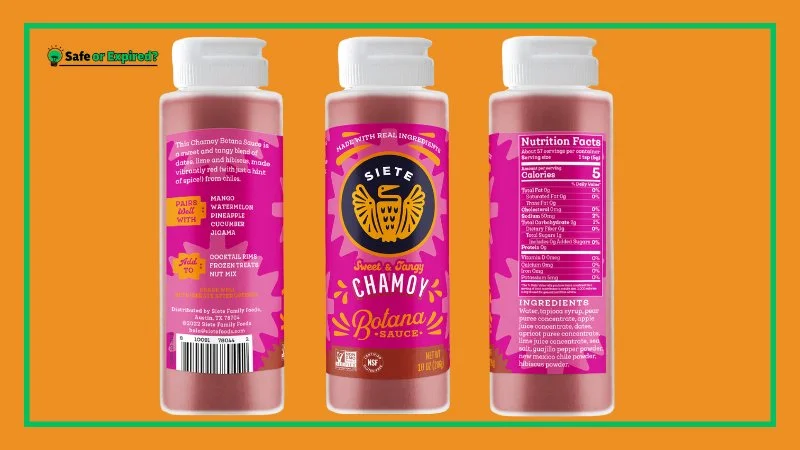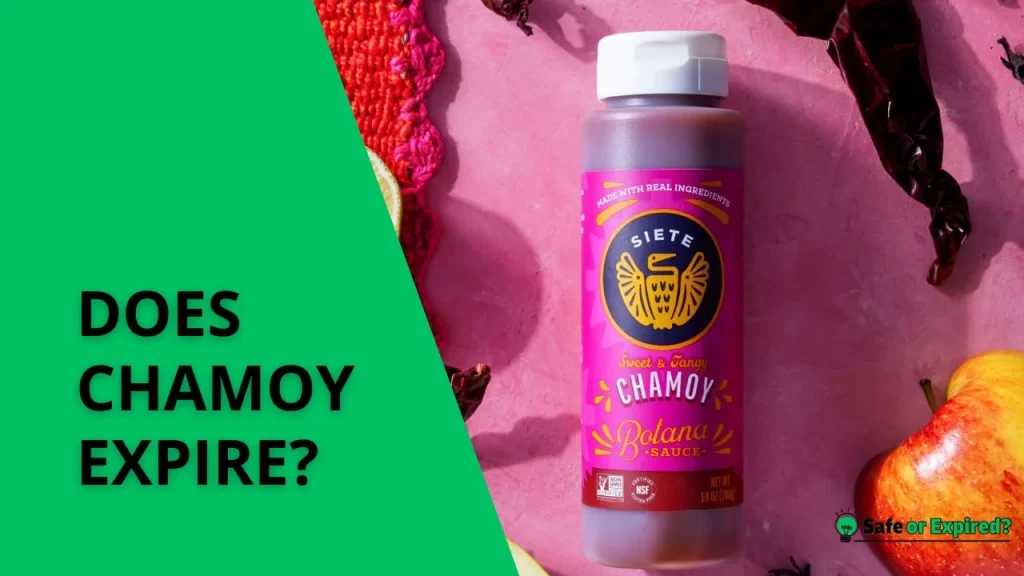“Does chamoy expire?” is a typical chef’s query, and the answer is yes. However, it’s critical you know all about the chamoy expiration, as things are not straightforward.
Understanding how to store chamoy properly and recognizing when it’s no longer suitable to use can help you enjoy its vibrant taste. Let’s explore the shelf life of chamoy, effective storage methods, and tell-tale signs of spoilage in detail.
Does Chamoy Expire? [All-inclusive Details]
Yes, chamoy does expire, but not in a traditional sense. You can consume it if its quality stays good. However, if you feel a change in texture, the chamoy has gone bad. Therefore, always look for spoilage signs before you use the sauce.
You might wonder, “How long does chamoy expire?” Unopened chamoy can last up to 2 years if stored properly in a dry place. Once opened, it’s best to refrigerate it and use it within 6 to 12 months to ensure its quality and taste remain optimal.
Note that chamoy’s expiration depends on several factors, including:
- Ingredients
- Preservatives used
- How it’s stored

Typically, an unopened bottle of chamoy can last up to two years if stored properly. This long shelf life is due to the preservatives and high salt content, which inhibit the growth of bacteria and mold.
Once you open a bottle of chamoy, the clock starts ticking faster. When exposed to air, the preservatives begin to lose effectiveness, and the risk of contamination increases. That’s why an opened bottle of chamoy is best consumed within 6 to 12 months.
To Fridge or Not to Fridge?
Storing opened chamoy in the refrigerator is the best way to extend its shelf life. The cold temperature slows the degradation process and keeps the preservatives working effectively. In the fridge, an opened chamoy can maintain its quality for the upper range of its shelf life, which is closer to 12 months.
On the other hand, if you leave an opened bottle of chamoy out at room temperature, expect its quality to decline faster. It might still be safe to consume for a while, but it’s likely to lose its optimal flavor and texture within a few months.
Here’s a table about it.
| Storage Condition | Opened Chamoy | Unopened Chamoy |
|---|---|---|
| Counter | Not recommended. Once opened, chamoy should not be stored at room temperature. | Lasts until the “best by” date, which is typically up to 2 years. |
| Fridge | Recommended. It can last 6 to 12 months when appropriately stored in the fridge. | If you prefer to refrigerate unopened chamoy, the stable, cool environment can allow it to extend slightly beyond the “best by” date. |
Why Does Chamoy Expire? [Main reasons]
Chamoy expires due to the natural degradation of its ingredients and the eventual ineffectiveness of its preservatives. Over time, exposure to air, light, and fluctuating temperatures can lead to chemical changes, affecting taste, color, and safety.
Additionally, once opened, chamoy can become contaminated with bacteria or mold from the environment or dipping utensils back into the bottle. Let’s look at all the signs of soiled chamoy.
Discussing how chamoy might expire, we also look at other condiments to see how they stack up. Just like chamoy, they need proper storage to stay good. Wondering about Manwich? It’s great for quick meals but has an expiration date to watch. Learn more in “How Long Is Manwich Good For After Expiration Date? Deadline.”
What Are the Signs of Spoiled Chamoy? Look Out For these!
The main signs of spoiled chamoy are foul odor, mold growth, and change in texture. Temperature fluctuation, air, moisture, bacteria, and other contaminants can cause this. You may also feel the change in taste. Sometimes, the sauce can discolor as well.
Unusual Odor
An off smell is among the first signs that your chamoy is past its prime. Fresh chamoy has a distinctive, inviting aroma that complements its taste profile. If you notice any foul, sour, or otherwise unpleasant smells emanating from the bottle, it clearly indicates that the chamoy has started to spoil.
Mold Growth
Visible mold growth is a definite sign that chamoy has gone bad. It usually appears as fuzzy spots in various colors, including white, green, or black, on the surface of the chamoy or inside the bottle’s cap.
Note that eating moldy food can lead to health issues, so if you spot any mold, it’s time to throw the chamoy away. Remember, mold spores can spread throughout the product, so even if only a small area appears affected, the entire bottle should be considered contaminated.
Furthermore, examine the bottle before using it. If you notice any leakage, mold, or pest infestation, then discard it. Here’s what a top-quality Chamoy bottle looks like:

Change in Texture
Chamoy typically has a consistent texture, depending on its form (sauce, paste, or powder). If you notice any changes, such as separation, thickening, or becoming overly watery, it may indicate spoilage.
A change in texture doesn’t always mean the product is unsafe to eat, but it can affect the quality and taste of the chamoy. If the texture seems significantly different from when it was first opened, it’s best to discard it.
Altered Taste
If chamoy passes the visual and smell tests, you might be tempted to taste it to determine if it’s still good. However, this should be done with caution. If there’s any hint of a sour or bitter taste that deviates from its original flavor profile, the chamoy has likely spoiled.
Discoloration
Fresh chamoy has a vibrant color that can range from deep red to bright orange, depending on its ingredients. Any noticeable discoloration, such as a dull or faded appearance, could be a sign of degradation.
However, some color changes may occur naturally over time. They don’t necessarily indicate spoilage. Still, take significant discoloration seriously and discard such chamoy.
Similarly, if you’re using Frank’s Hot Sauce to spice up your dishes, you might wonder about its shelf life. Does it last indefinitely, or does it start to lose its potency over time? For answers, see our exploration in “Does Frank’s Hot Sauce Expire? Yes or No? (Find Out)”.
How to Store Chamoy to Extend Its Shelf Life? Key Tips
To store chamoy to extend its shelf life, the first thing to do is to put the sauce in a cool and dark place. Refrigeration is also a great choice. In addition, you should also clean utensils and keep looking for any signs of spoilage. Furthermore, consider decanting.
Keep It Cool and Dark
Before opening, chamoy should be stored in a cool, dark place, such as a pantry or cupboard. Exposure to heat/light can accelerate the degradation of chamoy’s flavors and preservatives, leading to quicker spoilage.
Remember that a stable, cool environment helps preserve the integrity of its ingredients. This will ultimately extend its shelf life up to its maximum potential—often two years or more for unopened bottles.
Refrigerate After Opening
Once you’ve opened a bottle of chamoy, the best place to store it is in the refrigerator. The cooler temperatures slow down any bacteria and preserve the condiment’s quality over time.
When refrigerated, opened chamoy can last between 6 to 12 months, sometimes even longer, without losing its distinctive taste.
Use Clean Utensils
To avoid introducing bacteria into the chamoy, always use clean, dry utensils when serving or scooping it out. This practice helps prevent cross-contamination, which can lead to spoilage. It’s a simple step that can significantly extend the shelf life of your chamoy by keeping it as sanitary as possible.
Check for Signs of Spoilage
Regularly inspect your chamoy for signs of spoilage, such as an off odor, mold growth, changes in texture, altered taste, or discoloration. If you notice any of these signs, it’s best to discard the chamoy to avoid health risks. Being vigilant can help you identify when chamoy has gone bad, ensuring you only consume it when it’s safe and of the best quality.
Consider Decanting
If you’ve purchased chamoy in bulk, consider decanting it into smaller, airtight containers. This can help extend its shelf life by reducing the amount of chamoy exposed to air each time you use it. Smaller containers also mean that you can keep larger quantities in the pantry until needed, refrigerating only what you’ll use in the short term.
And what about mustard? Whether it’s seeds, powder, or oil, knowing when it’s gone bad is important. Check the signs and safety tips in “Can You Eat Expired Mustard? (Seeds vs Powder vs Oil)”.
Conclusion
Chamoy, a staple in many kitchens for its dynamic flavor, does indeed have an expiration timeline. Here’s a summary of everything we discussed about the expiration:
- Chamoy is expired if you see signs of spoilage, like a change in taste.
- You significantly extended with proper storage.
- Keep unopened chamoy in cool, dark places and refrigerate it once opened.
- Remember to use clean utensils to avoid contamination and keep an eye out for any signs of spoilage.
You can now ensure that your chamoy remains fresh and delicious, ready to enhance your favorite dishes and snacks at a moment’s notice. So go ahead and relish the zesty goodness of chamoy without worry, knowing exactly how to keep it at its best.

